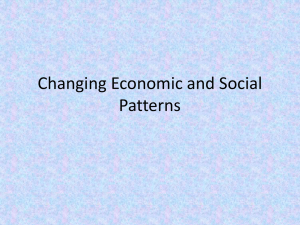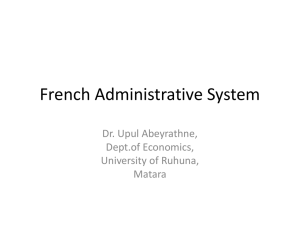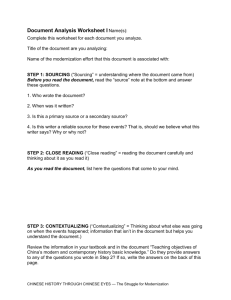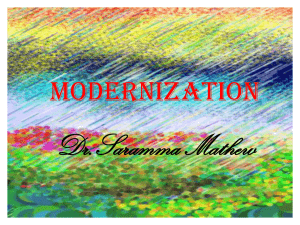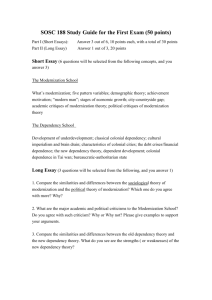What is an argument
advertisement
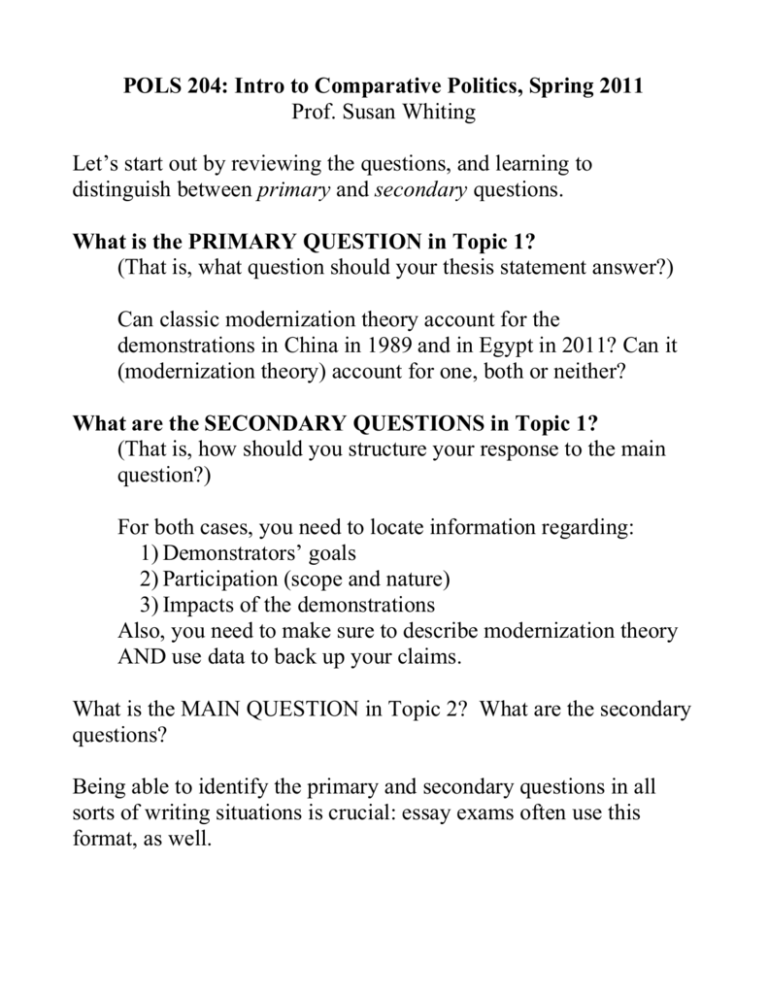
POLS 204: Intro to Comparative Politics, Spring 2011 Prof. Susan Whiting Let’s start out by reviewing the questions, and learning to distinguish between primary and secondary questions. What is the PRIMARY QUESTION in Topic 1? (That is, what question should your thesis statement answer?) Can classic modernization theory account for the demonstrations in China in 1989 and in Egypt in 2011? Can it (modernization theory) account for one, both or neither? What are the SECONDARY QUESTIONS in Topic 1? (That is, how should you structure your response to the main question?) For both cases, you need to locate information regarding: 1) Demonstrators’ goals 2) Participation (scope and nature) 3) Impacts of the demonstrations Also, you need to make sure to describe modernization theory AND use data to back up your claims. What is the MAIN QUESTION in Topic 2? What are the secondary questions? Being able to identify the primary and secondary questions in all sorts of writing situations is crucial: essay exams often use this format, as well. Good papers always include the following components. 1) An Introduction A colleague said that if the introduction is clear enough, I should be able to hand it off to another person who has done all the same reading, and s/he would be able to complete the assignment as planned. a) A clear statement of the paper’s focus (“Modernization theory argues that…” v. “All people yearn for freedom.”) b) Brief references to the specific events or arguments under discussion (“Although it might seem that there is little connection between Tiananmen Square in 1989 and Tahrir Square in 2011, modernization theory…” v. “People rose up to challenge their leaders…”) c) A thesis statement: here are some examples. 1) Modernization theory does not adequately account for the demonstrations in either Beijing or Cairo, because A, B, and C. 2) Iraq’s institutional design in combination with its electoral system, has actually minimized political instability and stalemate, as demonstrated by A, B, and C. d) A roadmap (“First, I will discuss the relevant points of modernization theory, including a discussion of X, Y, and Z. I will then apply the theory to the cases of China in 1989 and Egypt in 2011 using data from… Finally, I will…”) 2) A Thesis Statement/Statement of the Argument a) An assertion, backed by evidence, which is falsifiable. Not open for debate/YAWN: “Both the Chinese and Egyptian governments were oppressive at the time of the uprisings.” Open for debate/INTERESTING: “The Chinese demonstrations— characterized by 1, 2, and 3—perfectly illustrate modernization theory, while the Egyptian demonstrations—characterized by 7, 8, and 9—trouble the neat distinctions that modernization theory relies on: as a result, modernization theory nicely explains the Chinese uprising in 1989, but is less satisfactory when applied to the case of Egypt in 2011.” b) The thesis statement answers the question that animates the paper. So if the question is “How do institutional design and the structure of the electoral system impact political instability in Iraq?”, your thesis statement should respond to that question. i) Here are some possible ways to answer this question: (1) Iraq’s electoral system has increased political instability while the structure of the political institutions has very little impact, as shown by A, B, and C. (2) The institutional design of Iraq’s government—semipresidential—and its electoral system—proportional representation—both decrease political instability, because A, B, and C. b) The thesis statement is NOT a i) statement of fact: “Neither China nor Egypt have a history of democratic political institutions” ii) Or of opinion “China will never be a democracy.” 2) Evidence a) Scholarly sources are ideal, but given how recent the issues in Iraq and Egypt are, we are relaxing this constraint a bit. Good sources are those that aspire to unbiasedness. i) Focus on sources like The Economist, The New York Times, The Washington Post, etc. rather than a pro-democracy website in Iraq or a pro-army website in Egypt. b) For both questions, you will need to have i) a thoughtful discussion of what each theory predicts (1) modernization theory in topic 1 (2) institutional design AND electoral systems in topic 2 ii) actual data for the countries you are considering (1) from the sources provided (2) from additional sources you must locate iii) A discussion of the fit between theory and data. (1) Do these cases confirm the theory/ies or disprove the theory/ies? 3) The argument a) Evidence and/or logical inference should be used to persuade the reader of the correctness of your thesis statement. b) The argument should argue for something rather than describe things. It is crucial that your paper NOT merely describe the situation, but instead analyze and make an argument about the situation. c) Paragraphs should come in the correct order and have clear and strong topic sentences. 4) Acknowledge disconfirming evidence a) If evidence doesn’t fit the theory, you should mention that and make a judgment call. i) Does this single bit of information disconfirm the theory? ii) Is available data flawed? iii) Is there is some other problem? 6) Conclusion a) The conclusion is essentially a rear-view mirror. b) It introduces no new evidence. c) Conclusions remind the reader why this question is important: the ‘so what/who cares’ question should absolutely be clear. Final Tips/Considerations You may use whatever citation style you wish, but all citations must be internally consistent. That is, if you use Chicago 16th for all but one citation which is in MLA format, that is not internally consistent. Cite everything you did not know before you took this class o Citations are not just for quotes!!! They are for ideas, phrases, and paraphrases, too. o It’s always better to over-cite than under-cite. o This does not necessarily mean every sentence has a citation, but it does mean that whenever you rely on the insights offered or evidence gathered by someone else, you give them credit. Start EARLY (no later than March 5). Plagiarism is often the result of procrastination or confusion about the assignment: the best way to avoid that is to start early. Then, you can work through confusion or points of frustration BEFORE the paper is due. Give yourself deadlines for intermediate steps. o Feb 28: Make sure you understand the theories under discussion and have located good sources. If you are having problems, GO TALK TO YOUR TA!!! o March 5: Rough Outline with Provisional Thesis and Topic Sentences. o March 12-13: Crank out a Rough Draft. o March 14: Get someone else to read your draft. o March 15-16: Revise and edit. (And take other finals.) o March 17: Turn your paper in.

